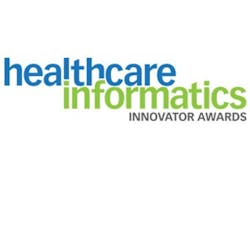Innovation is taking place across the various sectors of U.S. healthcare—not only across the provider sector, but also across the vendor sector. The editors of Healthcare Informatics asked an esteemed panel of national industry leaders to evaluate submissions from dozens of solutions providers in five critical areas of innovation development; below are the firms whose solutions our judges identified as offering the most promise to help transform healthcare.
Innovation in Value-Based Healthcare: Holon Solutions
The 2018 winner in the value-based healthcare category is Holon Solutions, an Alpharetta, Ga-based firm that helps healthcare organizations across the country “liberate” their data, in order to provide physicians with the information they need at the point of care. Chief Executive Officer (CEO) of Holon Solutions, Bryant Castleton, Chief Strategy Officer (CSO), Robert Connely, and Chief Commercial Officer (CCO), Julie Mann spoke with Healthcare Informatics about why population health needs to be about the present as much as the past–and the importance of partnerships to enable true value in the healthcare space.
Tell me about Holon Solutions’ vision for value-based healthcare.
Robert Connely, CSO: We see the same paradigm happening in healthcare over and over again. In the 80’s and 90’s, we had managed care and capitation. That was value-based care in its infancy. But the problem was that there wasn’t a lot of technology augmentation to help providers cross the bridge to true value-based care.
What we’ve learned, as things have progressed, is that technology can be an enabler. If we can know when a specific patient falls into a specific value-based contract arrangement, with their insurance company, with their doctor at the point of care, what kind of information should that doctor know so they can take the right action? We serve actionable insights—the kind of insights that when surfaced at the point of care, have a tangible impact on value-based care. The kind of insights that can shift cost curves and value metrics going forward.
There are companies coming out of the woodwork every day trying to make population health a reality. They want to be able to stratify the risk by putting people into different buckets and then analyzing the data to understand where an organization may have fallen short the past year. But they are working in the past. Holon is turning that strategy on its head. We want to take population health and put it in the present. Instead of looking at data that so many population health analytics vendors know about their patients in an aggregate view, we want to give that information to the doctors when they need it the most: when the patient is physically in the room with them. That allows them to take meaningful action and make a difference for that patient, and for the organization, right then and there. Our patent-pending interoperability solution equips our customers with this capability for the first time—at scale and agnostically.
How do you see the competitive marketplace moving in the value-based healthcare space?
Bryant Castleton, CEO: While independent physicians have invested in their own electronic medical records (EMRs), larger health systems would prefer providers deploy to their monolithic systems such as Epic or Cerner. Affiliated physicians that value their independence and autonomy want to stay in the solution they have invested in and are accustomed to. We’re able to partner with the health systems and help deliver the population health information to the affiliate at their point of care and within their workflow, regardless of their EMR. This is a true win/win for the health system and the independent physician.
The reality is that, while a lot of physicians have consolidated and joined health systems, many value their independence and healthcare will never be absolutely monolithic. Migrating all users onto a single EMR platform or data standard is never going to be realistic for everyone. Our solution operates as a bridge for the many disparate healthcare technologies to provide truly meaningful solution for the connectivity challenges organizations face.
Bryant Castleton
To what do you attribute Holon Solutions’ success?
Bryant Castleton, CEO: Great partnerships—both internally and on the customer front. As CEO, I to surround myself with people that are a lot smarter than me. We always look to hire all-stars, brilliant people who share our values, understand our mission and can help us do what we say we will do for our customers.
But it’s also about working with great customers. We are privileged to work with some of the true thought leaders in healthcare today. Our customers give us great feedback as we build up our solutions so we can make them even better. We started building our CollaborNet platform several years ago. During this period, a couple of hand-selected organizations partnered with us to launch it, test it, and refine it. This year, as we officially go to market, we know our solution is robust and ready for prime time, because our partners have already helped prove it out.
How do you see the future—both in terms of challenges and opportunities—when it comes to value-based healthcare?
Julie Mann, CCO: The future of value-based care is dependent on collaboration. Some of the key challenges have been fragmented technologies and a multi-payer system with a growing list of quality metrics. With these challenges, the clear opportunity for organizations to achieve value-based care success is through collaboration. Our team has reimagined interoperability. Our first-to-market solution enables fragmented technologies to communicate with each other by leveraging our sensor-based technology. This break-through allows our customers to link insights across their sea of platforms. We compliment the technologies by allowing them to speak to each other and maintaining contextual awareness. Additionally, our solution empowers organizations with the ability to push universal alerts out to their providers, regardless of the EMR in play. For value-based care to be successful, you need that kind of conduit.
To learn more about Holon Solutions and their solutions, visit http://www.holonsolutions.com/.
Innovation in Data Analytics: axialHealthcare
The 2018 winner in the category of Data Analytics is axialHealthcare, a Nashville, Tenn.-based company that helps provide data-driven insights to payer and provider organizations regarding pain management. Chief Science Officer (CSO) of Axial Healthcare, Elizabeth Ann Stringer, Ph.D., spoke with Healthcare Informatics about staying agile—and understanding how to use your data to enhance both quality care and your organization’s bottom line today.
Tell me about axialHealthcare's vision for data analytics in healthcare.
Elizabeth Ann Stringer: axialHealthcare is a pain and opioid healthcare company that works with payer organizations. Our value proposition is in how we analyze data and then integrate that into technological solutions that are placed directly in the workflow of our end users. To dive a bit deeper, we start with claims-based data analysis with the goals of decreasing costs, optimizing coverage, and increasing the quality of care being delivered to their members. We focus on this subset of the member population that’s in pain and are being subscribed opioids, and then try to identify who may have an opioid use disorder.
There aren’t just one or two diagnosis codes that identify members who are in pain. It isn’t always the easiest thing to determine. We often say, “These members are everywhere, but they’re nowhere,” because they can be so hard to find. Our goal is to identify them and the providers who care for them—so we can better triage, prioritize, and then match those members with the different care solutions that we have. Our data analytics models help us stratify this population.
We can do the same for the providers themselves. We can assess them and their behavior patterns and then score them on how they are providing care. It allows us to highlight the providers who are doing a great job. But also identify providers who may need more outreach, education, and support so they can better care for this challenging population of patients.
Elizabeth Ann Stringer, Ph.D.
How do you see the competitive marketplace moving in the data analytics space?
Elizabeth Ann Stringer: It’s an interesting time. Big data is everywhere, both inside and outside the healthcare system. Everyone is interested in data but what’s less apparent is what to do with it. How can you use it to make better decisions?
We believe it is necessary, within the realm of data analytics, to bring together multi-disciplinary teams. These teams should include the data scientists who understand the questions you want to ask—how to set up a problem and test a hypothesis. They need statisticians to ensure the accuracy and statistical integrity of the data. They need a Masters of Public Health to think more broadly about the impact on the healthcare system. They need someone who can talk about medical economics. Because, at the end of the day, that’s what is driving so much of this. Yes, we want access to quality care but if you can’t affect the bottom line, it’s going to be difficult to bring in revenue and affect change.
There is a wealth of data out there but you need to filter it and shape it in a way so it can be used for analysis. You need people who can not only understand the analysis but also tell a good story about what it means—connecting with business buyers and helping them understand the value. Building these multi-disciplinary teams is going to be more and more important in healthcare. Too often, now, we have data scientists who are isolated, not integrated well into their organizations, and unable to help their organizations really use their output. We need these functional teams to communicate and share ideas so that once an opportunity is identified, it doesn’t take another twelve months to make a change.
To what do you attribute axialHealthcare's success?
Elizabeth Ann Stringer: It goes back to those multi-disciplinary teams. Our success can be attributed to bringing all those key players together. We have the right people who can align themselves with the business of healthcare, move quickly, and appreciate the expertise and contributions from other team members who come from different backgrounds.
We wouldn’t be where we are today if all of these different players with their different expertise and experience weren’t coming together to solve this problem of pain management. The opioid epidemic is huge and it continues to evolve. It takes a lot of talent to be able to respond to that.
How do you see the future—both in terms of challenges and opportunities—when it comes to data analytics?
Elizabeth Ann Stringer: We know that the opioid epidemic continues to evolve. But it’s the same in healthcare. There’s so much uncertainty about where healthcare is going. It’s driving a large part of our national deficit. Real changes need to happen for any sort of sustainability in the field. Having the tools on hand to be adaptable is necessary for any organization within healthcare right now. Axial has done a good job of adapting. So many organizations are stuck on what worked well last year, or even 10 years ago, or what’s specific to their region of the country. We can learn from that history, of course, but we can’t put too much emphasis on the past if we are to move forward.
Being able to respond quickly takes an iterative approach. At Axial, we want to refine and enhance our offerings so we can help healthcare organizations identify opportunities that are readily actionable today and then start prioritizing them. Tackle those changes, see how the market responds, see how it improves care, and then move on to the next enhancement. That’s what it’s going to take.
To learn more about axialHealthcare and their solutions, visit https://axialhealthcare.com/.
Innovation in Patient Engagement: LexisNexis Health Care
For years, hospital providers have calculated risk on claims history and financial risk-scoring. But the ability to improve risk stratification and care services has never really gotten down to the individual consumer level of wellness engagement—until now.
LexisNexis Health Care has embraced the ground-level realities of population health by combining socioeconomic data with traditional risk-scoring data in a service that provides predictive data on a patient’s ability to participate in his or her own health wellness.
Most providers have access to barrels of financial and claims data yet have relatively little information on who their patients really are, including what socioeconomic factors are affecting their lives. Everything from access to public transportation to economic hardships in accessing healthy food can affect how well patients’ outcomes continue once they leave the provider and go back home. Social factors even contribute to one in three deaths in the U.S., according to a National Institutes of Health study.
“Social determinants are really important in driving patient engagement in healthcare,” says Josh Schoeller, vice president of client engagement, LexisNexis Health Care, based in Alpharetta, Ga. “We wanted to build models utilizing social determinants of health attributes and be able to clinically validate them via claims information. That gave us models to rank patients’ overall health risk in a more accurate way by getting down deeper and looking at their individual patient engagement and risk factors.”
Josh Schoeller
The emergence of the healthcare insurance marketplace has muddied the risk pool further, especially when consumers leave interrupted trails of claims history as they hop back and forth among different insurance plans. How can providers do meaningful risk-scoring on patients that don’t have a clear, unbroken claims history record? “In the absence of clinical history, the social determinants of healthcare are much stronger than just the age/gender model.”
The LexisNexis Socioeconomic Attributes and Risk Scores solution is built on public and proprietary records data from more than 280 million adults. Its algorithms consider 442 different attributes (as of February 2018) that correlate to health outcomes including everything from risk based on the total cost of healthcare to an individual’s medication adherence.
The resulting analytical data can be used to provide person-centered educational messages and reminders to high-risk patients. While not every diabetic patient needs a high level of case management, some patients do, Schoeller explains. The service’s features allow providers to be deeply hands-on when it comes to chronic disease management by fine-tuning interventions and educational messaging to specific risk subgroups within any patient population.
“Some providers told us, ‘We really want to use this on our full population,’ while others said, ‘We really want to focus on our over-65,’” Schoeller says. “We can slice and dice all that and add business filters to deal with special populations like Medicare and Medicaid.”
Empowering patients to learn more about their health and to participate in healthy decisions has direct impact on outcomes and readmission rates. “It’s getting more common that pharmacies will be paid a higher reimbursement if patients are compliant in picking up their medications.” Identifying socioeconomic risk also shows providers where targeted outreach programs, support groups and financial assistance programs may have the greatest impact.
Having access to risk data allows providers to prioritize and focus on the highest utilizers, but that’s not the whole story. “In order to really take action, you need to get down deeper and start looking at what the risk factors are,” Schoeller says. “If I’m high risk, how can providers apply their approach differently to get me more engaged or get me in a better position to drive better outcomes? It’s a new level of understanding what is driving potential risks and how we can get in front of that.”
Convincing the provider market of the solution’s value wasn’t exactly easy at first. LexisNexis had to counter the industry’s lack of understanding about how socioeconomic data could fit into clinical workflows in order to get providers to see why the new data capabilities were such a game-changer, Schoeller remembers.
In terms of potential, the concept of using socioeconomic data in analytics is still in its infancy, Schoeller says. “The industry has the risk-scoring piece and the patient education piece. Now we need to get into the ethics, the access and the correlations of all that information, and integrate it into the clinician’s workflow. It needs to be correlated to be actionable,” he insists. “If we know a patient has a higher risk for readmission, then let’s give them some virtual reality videos and download some information about their injury onto their cell phone.”
Patients with chronic illnesses offer an even greater opportunity, Schoeller adds: “A big part of this is about how to keep patients with chronic conditions from going into a catastrophic state. How do we manage chronic conditions more proactively and get great rankings for better outcomes?”
To learn more about LexisNexis Health Care and their solutions, visit https://www.lexisnexis.com/en-us/health-care/default.page.
Innovation in Data Security: Valimail
The 2018 winner in the category of Data Security is Valimail, a San Francisco, Calif.-based company that helps healthcare organizations gain full control and visibility into their email services through fully automated email authentication services. Co-founder and Chief Executive Officer (CEO) of Valimail, Alexander García-Tobar, spoke with Healthcare Informatics about email’s “original sin”—and how to find the right balance between security attacks and security solutions for optimal protection.
Tell me about Valimail’s vision for data security in Healthcare.
Alexander García-Tobar: When you look at security, you have to balance the ease in which a criminal can attack your organization, the damage that attack can cause, and how hard it is for a healthcare organization to implement the solution that can stop those attacks. There is no question that email impersonation attacks are the easiest for criminals to implement. And one of the primary ways that patient health information (PHI) gets lost is through emails. So people need to look at email authentication to defend themselves.
Valimail’s main goal is to authenticate email and to automate that process. What that means, in a nutshell, is that we want to stop fake email. If you look at the scourge of phishing attacks, the majority come from people sending out what we call impersonation attacks. Bad actors pretend to be a hospital, a provider, or an insurance company and they trick you into revealing sensitive information.
Email’s original sin is that anyone can claim to be anyone on an email. There’s that old New Yorker joke that said, “On the Internet, no one knows you’re a dog.” On email, no one knows who you are. Criminals take advantage of this. These impersonation attacks do not get solved by traditional filtering approaches. You need to authenticate—and, when you look at balancing out the security equation, this is one of the easiest things that healthcare organizations can do in order to protect themselves.
Alexander García-Tobar
How do you see the competitive marketplace moving in the data security space?
Alexander García-Tobar: In the past, people have tried to do email security to look and see if there’s a virus or bad link in the emails. But the thing about impersonation attacks is that there’s nothing to filter. Someone is pretending to be someone they are not. So to address these issues you need to authenticate the email.
The problem is that getting authentication right is extremely hard. When we looked at the healthcare sector, at a collection of about 216 provider and insurer domains with revenues $1 billion and over, over 78% of them did not have any email authentication in place. These are the largest companies in healthcare and the vast majority do not have the ability to stop these impersonation attacks from occurring. Of those 216, only 8 were fully protected. That’s not enough. The healthcare industry is particularly vulnerable to impersonation attacks because it deals with extremely sensitive personal information. Criminals play on our fears and, because of that, large damages can occur, both financially and socially.
When we started Valimail, we saw that current authentication vendors were, at best, succeeding 40 percent of the time with their clients. And a solution that works less than half the time is not really a solution. We saw that this process needed to be automated. We needed to be able to guarantee that we could get our clients to what we call enforcement, the place where they can stop the bad stuff from happening. We needed to plug this gap so healthcare organizations could better protect their data.
To what do you attribute Valimail’s success?
Alexander García-Tobar: The traditional ways that many companies were trying to do authentication fail 70 to 80 percent of the time. We’re bringing in a 100-percent guaranteed way of getting our clients to enforcement in a totally automated fashion. A lot of the first generation vendors offer solutions that are manual and fail at extremely high rates. Making the authentication process automated really makes a big difference.
The first generation of authentication providers came to market five years ago. We’re the first company after that initial wave who came in and said we need to start from scratch—a solution that only works half the time is not a solution. So we asked ourselves, if we started with a blank piece of paper, how could we design a system that would work 100% of the time in this cloud era we now live in? I attribute our success to creating a clean and purposeful technological solution. By understanding the first generation issues, we could avoid the same pitfalls. And by automating the process, we give our clients a solution that works—and one that they don’t have to be constantly working on manually for it to work.
How do you see the future—both in terms of challenges and opportunities—when it comes to data security?
Alexander García-Tobar: The mission of any security vendor is to push criminals into having to use more expensive and complex ways to steal your data or commit a crime.
So often, the easiest and most damaging ways are wide open to these guys. Impersonation attacks are really easy. Just about anyone can write an email pretending to be an insurance administrator or provider in about three seconds. My 8-year-old can do it. That means, essentially, the most dangerous types of attacks are the easiest for criminals to implement. It’s the worst possible combination. We need to work harder to make sure that these attacks are sealed off to criminals.
In the next year, we’re coming out with new solutions to address lookalike domains—where the criminals have registered a domain that looks like yours except there’s a zero in place of an O. We are also working on an Internet of Things (IoT) authentication solution. This is for all the medical devices out there in healthcare. So many healthcare devices are connected to the Internet. And if they are plugged into the Internet, there’s the possibility that they can be vulnerable to updates or hacks. We need to be able to authenticate not only email but also devices. That’s the next challenge.
To learn more about Valimail and their award-winning solution for email authentication for payer, provider, and other healthcare organizations, visit https://www.valimail.com/.
Innovation in Revenue Cycle Management: Revenue Cycle Management
Revenue cycle management (RCM) has long included the tracking of material assets and costs, but these days, a provider’s most important financial asset is its own patients’ ability to pay.
The recent, formidable shifts in the payer landscape have pushed far greater payment responsibilities on to the consumer, revealing dangerous gaps in a patient’s awareness of the costs associated with procedures and services. While fee schedules and claims history data are the go-to data sets in cost estimation, few providers have found ways to harvest both data sets at once—and to incorporate consumer-friendly ways to collect everything from copays to final costs.
Navicure, which merged with ZirMed in February to become Waystar, has combined the value of multiple data silos into a single software solution capable of delivering accurate cost estimates and processing financial transactions, including automated payments.
The company’s respective Payments and Care Estimator solutions meld deep data on the cost of services with payment engines designed to gather payments directly from consumers in a timely and accurate way. “So much of the RCM technology has been focused on the back end,” says Matt Hawkins, CEO. “Now we can use technology to reduce the time to collect, manage any denials and bring clarity and transparency to what the patient owes and why.”
Matt Hawkins
The Navicure solution is the marriage of a consumer-focused cost estimator and a provider-focused claims processing system, and it’s about time those two data sets join, Hawkins notes. The “bill and chase” strategy is long out of date—Increasingly, consumers are asking providers for accurate cost estimates upfront while taking the mystery out of the claims billing and payment processes.
The cloud-based solution, offered as software-as-a-service, allows clients to choose the depth of desired features—anything from a “data-learning” basis on the cost-to-payment ratios to deep dives into the data analytics on specific procedures or patient groups. The latter features will surely be attractive to accountable care organizations and/or organizations that specialize in procedures that qualify for bundling or that Medicare governs.
“The software’s deep data analytics and sophisticated algorithms have resulted in a 98 percent go-rate for claims processing on the first submission,” Hawkins says. “By combining accurate coding with clean data on insurer coverage and the patient’s financial responsibility, it brings clarity and integrity to the entire experience for the patients and their insurers.”
Another change-driver is the emergence of the Healthcare Insurance Marketplace, born out of the Accountable Care Act—many new policies appearing on the marketplace are shifting from dollar-based co-pays to percentage-based responsibilities for certain services, either before or after the deductible is met. That means those consumers now need a way to estimate what “20 percent of a procedure” costs.
While the industry has made decent strides in standardizing EDI and eligibility, it has fallen short when it comes to bringing accurate cost estimate information to the consumer level. Providers still say many patients have little idea what their coverage includes or what portion of the costs they’re responsible for paying, adds Ken Bradley, vice president of strategic initiatives. “Providers have to navigate patients through this all the time—what’s covered, what’s not covered and why. Providing better cost estimates using multiple sources of data can give providers a way to offer patients an accurate estimate while increasing provider confidence in their ability to pay,” he says. “We’re still dealing with an industry that’s highly fragmented, but there are ways to make the data more dynamic in analyzing all the payer complexities. We’ve taken something really complicated and tried to simplify it.”
Giving providers a way to help patients get beyond the “sticker shock” (and to be confident in patients’ ability to pay their part of the bill) means generating cost estimates with high accuracy—and that takes the power of combined data sets, a clean cost estimator and a streamlined payment collections interface.
As consumers take on more of the heavy lifting for their own healthcare costs, providers can expect a lot more window-shopping on services. The ability to provide the transparency of accurate cost estimates upfront in the patient engagement process could become a market edge.
The vibrant market consolidation across care segments just exacerbates the need for more and better consumer information on costs, Hawkins notes. “Provider organizations are growing beyond hospitals into primary care offices, rehabilitation and home health. Then, there are the new players moving into the healthcare space, like Amazon. We know the focus will be on the technology it takes to solve the reimbursement complexities and empower the patient to actively pay for their healthcare services.”







